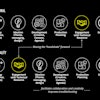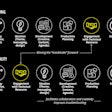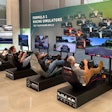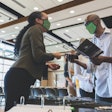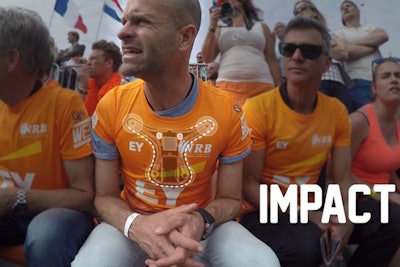
The term “wearable technology” most often conjures up images of activity trackers such as a FitBit or smart accessories like the Apple Watch. But technology—things such as sensors, software, and other electronics—is also being integrated into apparel. And it’s being done in a way that it is intuitive and invisible, so a tech-enabled shirt looks more runway than robotic. One of the companies leading this effort is Wearable Experiments, founded by Ben Moir and Billie Whitehouse. The two gained attention in 2013 when they designed Fundawear remote-controlled underwear for condom company Durex. Since then they have been working on a variety of clothing items embedded with technology that can both entertain and inform. We spoke to Whitehouse about the company’s work and the future of wearable technology.
Your website describes Wearable Experiments a “socially driven wearable technology company.” Tell us more about what that means.
We do integration of hardware, software, apparel, and design. We are designing for an experience where we are thinking about technology as well as communication on the skin and how that enhances an experience. Whether it’s something you are watching on TV or it’s something you are using to get around a city, we are designing for experiences rather than individual clothing.
One of your products that has generated buzz is a jacket called Navigate that helps the person wearing it find a destination. How does that work?
You type in your phone the way you would using Google Maps where you’d like to travel to and you select which form of travel you are taking—whether you are biking, whether you are walking, or whether you are in a car. You put your phone back in your pocket or your handbag and the jacket will take over the navigation. It will tap you on the shoulder when to turn left, when to turn right, and then double tap when you arrive. Say you are at something like [International] C.E.S. and you don’t want to get lost the entire time. You can enter into the software in your smartphone, "I would like to see this product," and then the jacket will navigate you. We’re removing the screen as a distraction and giving the person their eyes back.
And you have designed shirts that help sports fans feel what is taking place on the field. Tell us about those.
We worked on a project called the Alert Shirt for Foxtel in Australia for the Australian Football League. We used real-time sports data to quantify the emotions of the game, figure out what emotional state players go through, and then how to replicate that for a fan, whether you are watching at home or you are watching in the stadium. You select in our app where you are watching and which team you would like to follow and then you feel the sensations of that team in your chest as you’re watching the game. It’s about bringing the fans closer to the players and bridging that empathy gap of what players actually go through. It allows you to have a little space from your dependency on a screen. You can have your back to it or you can be somewhere else and you still get the same sensation of what the players are going through. And this summer we released a similar product in Europe called the Netherlands Fan Jersey for the Dutch Ladies Sevens rugby team.
What is the benefit of integrating the technology into the clothing, versus having the user wear it in a wristband or watch?
It’s about having more than one data output. If you are talking about a watch or a wristband you are really only quantifying one experience that sits on your wrist, so it’s not a very holistic experience. Whereas our product, if you have multiple sensors or feedback or whatever it is, you are allowing for a far more glorified experience because it’s more than one data output.
What’s coming up next for Wearable Experiments?
We’re working on full fiber integration. How do we build all of these electronics inside the yarn? We are working closely with some new manufacturers to make it more invisible and even thinner than it was before. And some really sexy battery integration because up until now I don’t think people have thought about that part of the experience—the chargeability—how you have to recharge these things and how to make it sexy. So that’s what we are working on that really excites me enormously. When it comes to specific projects, we are highly focused on a particular type of athleisure clothing that crosses over into lifestyle as well as active wear because we believe these wearable technologies can help you in all walks of life.
What are your predictions for the future of this industry?
It’s really the very early days in this world. The possibilities are endless. And data is really the first leg into this long race. People are really trying to understand the consumer on a deeper level. The data is only a surface level right now. It can go well beyond that to heating the clothing or adding sound to the clothing. What we can do in terms of branding and brand integration is you actually begin building experiences so they are individualized. So it becomes far more about the consumer than it does about the brand.
Do you think the day will come that most of what we wear will have sensors and communication mechanisms built in?
It’s already being used in warehouses for safety and in medical practices. Most clothing already has technology into it anyway. There are R.F.I.D. tags on most garments that are sold. That is a form of technology that’s a tracking device. What I think is really important now is to make the user interface much more interesting. It’s really just how far can you let your mind go, and how far does the consumer want to go. The trick is right now they are comfortable with this being about activity, fitness, and wellness. How do you slowly say what are the next things they are comfortable taking on board. So it’s important to think first and foremost what do people want. But yes, 100 percent it will cross over into all walks of life.
While this is all very high-tech, you come from a design background, and in the end you are creating clothing that you hope people will want to wear. How challenging is that?
I think the bridge has always been that people have gone so far down the sci-fi path with aesthetics that people don’t think it’s comfortable. Whereas I think if you make it look as normal as possible, as comfortable as possible, as soft as possible, that it feels like an old piece of clothing, then the adoption will be there because it will be a beautiful piece of clothing. You have to want to buy the clothing without the technology. The clothing has to sell itself regardless.

